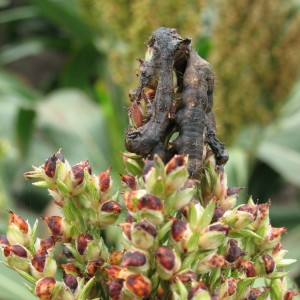What is NPV?
NPV stands for nucleopolyhedrovirus. NPV is a viral disease of Helicoverpa caterpillars that occurs naturally in the Australian environment. Australian farmers have access to commercially produced formulations of NPV for the control of Helicoverpa infestations in crops. NPV is safe and environmentally friendly. It is ideally suited for inclusion in an integrated pest management (IPM) approach to controlling Helicoverpa armigera and H. punctigera, the major insect pests in grain systems.
Where can NPV be used?
NPV can be used in a variety of field crops, including sorghum, cereals, chickpea, cotton and maize. In sorghum, NPV is the preferred product for Helicoverpa management, not only because it is very effective (frequently giving more than 90 per cent control) but because it preserves the full range of beneficial insects in the crop (e.g. Microplitis and Trichogramma wasps).
In crops other than sorghum, it is important to have realistic expectations of what NPV can achieve. In these crops, control varies and depends on a range of factors.
NPV can persist for years in a protected environment such as the soil, but is rapidly killed by exposure to ultraviolet light (sunlight) and high temperatures.
Why is NPV different to conventional insecticide?
One of the key differences between NPV and a conventional insecticide is that NPV is applied as a live disease. Therefore it is important to understand the NPV lifecycle to understand how it works.
Helicoverpa larvae have to eat NPV particles to become infected. These particles are called polyhedral inclusion bodies (PIBs). One PIB can be enough for NPV to successfully infect and kill the caterpillar. Once the PIB is ingested, the virus infects the gut cells, spreading to the blood within 24 hours, and then to almost all the tissues in the body.
Impact of NPV on pests
NPV can kill young larvae within 4 days of ingestion, older larvae within 5 to 7 days, depending on dose and temperature. The higher the dose and/or temperature, the faster the rate of infection and death. However, cool to cold temperatures can prolong the time NPV takes to kill its host to more than 10 days.
Diseased larvae typically climb to the top of the plant to die. Shortly after death, an infected larva’s body becomes flaccid and its skin ruptures, releasing millions of infectious virus particles back into the environment. When larval numbers are high, waves of natural infection can develop as more larvae become infected, die, and spread the infection, resulting in an outbreak.

NPV infected helicoverpa larvae
The commercially available NPVs only kill Helicoverpa larvae. They do not harm humans, wildlife or other insects.
- NPV is most effective on small larvae (less than 7 mm). Avoid targeting larvae over 13 mm.
- Crop coverage is critical as this is an ingestion product.
- Spray NPV when about 50% of the sorghum panicles have completed flowering (see label for instructions).
- Spray when larvae are actively feeding between 25°C and 35°C.
- NPV is harmless to wildlife and natural enemies of Helicoverpa.
- Use of additives with NPV will improve performance.
Further information
- Baculoviruses (Cornell University)
- Getting the most out of NPV (Beatsheet)
- ViVUS Max (AgBiTech)
